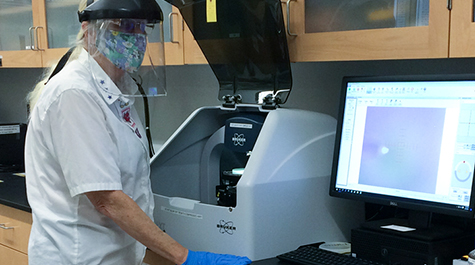Fall’s new normal in ARC core labs: scheduling, online operation, enhanced social distancing — and PPE
Things are going to be different this fall in the core labs of William & Mary’s Applied Research Center.
Amy Wilkerson, lab and research manager, says user services at the ARC will necessarily be more scheduled, include more online functions and will be conducted with strict attention to enhanced social distancing guidelines.
What won’t change, she said, is the dedication of the ARC staff to the research mission of the university and the commonwealth. Undergraduates, grad students and faculty will still have access to a wide range of instruments for analysis and characterization this fall, but social distancing guidelines will come with a necessity for a more deliberate way of doing business.
“Before, people would come by and look in. If, say, there was nobody using the Hirox microscope, they could come in,” Wilkerson said. “Drop-in users are not going to be allowed now.”
Users and staff will be required to don appropriate PPE, of course. And Wilkerson noted that in ARC lab spaces, the guideline is to maintain 10 feet between people, an increase in the usually recommended six feet. And yes, appropriate PPE — mask, gloves, face shield — will be required in addition to any other gear required for safe instrument operation.
“Core labs” are essentially a library of scientific instruments maintained for common use by the research community of an institution. The ARC is a major part of William & Mary’s core lab structure. ARC headquarters is in one of the prominent labs looking out onto the atrium of the Integrated Science Center, but there are ARC instruments in Small Hall and in McGlothlin-Street Hall. The ARC serves several hundred users each year, mostly faculty and students of William & Mary. A reciprocal agreement with other Virginia research institutions brings in researchers from across the commonwealth.
Wilkerson hopes to have most of a new-normal set of procedures in place by the beginning of the fall semester. She says her most immediate concern as that day approaches is how to conduct training. Standard procedure had essentially been to bring in a group of new users to the lab and everyone crowds around the instrument to learn.
“Sometimes we have four or five people gathered around,” she said. “Every once in a while, we’ll get a whole roomful. That can’t happen now. Any in-person training is going to have to be one-on-one.”
Wilkerson has been working with lab technicians Olga Trofimova and Song Vick on ways to replace the ARC’s traditional multi-person learning sessions.
“The plan is to have online training,” Wilkerson said. “Let’s say we’re talking about our Dektak surface profiler. What we want to have happen is to have an online practice program, because whenever you get even a new word-processing program, the hardest thing at first is learning where everything is.”
She put Vick in charge of arranging training: “I told her to not reinvent the wheel. Look at our equipment. Look at what other universities are doing. A lot of the manufacturers offer online training.”
The real challenge, Wilkerson said, will be arranging those one-on-one learning sessions on each instrument for each new user.
“With equipment,” she explained, “you have to get your hands on the instrument. You have to know what that fine-tuning feels like.”
Personal, hands-on acquaintance with a spectrometer or scanning electron microscope or indeed any of the other advanced instruments in the ARC is especially necessary if the user will be operating the device remotely. Wilkerson said she will be working with William & Mary’s Information Technology personnel to set up systems in which users can operate the instruments from their laptops.
“We can load their sample for them,” she said. “Or they can come in and load their sample, then take their laptop out into the atrium and run the program.”
Such remote operation will create space for the other lab equipment to be used during social distancing, but for control-by-laptop to work, the user has to thoroughly understand how the instrument works.
“If you’re going to operate something remotely, you’d better know everything about it,” Wilkerson said. “Because if you don’t know what you’re doing, you could click a button and crash the whole system.”
In mid-June, Wilkerson and her staff were determining which instruments are most suitable for remote operation. In general, the newer instruments are friendly with Windows 10, and are most likely to be set up for laptop operation first.
“But some of our equipment is 10 or 15 years old,” Wilkerson said. “They might be working on Windows 7 or even Windows 95. Is remote operation going to work on these devices? We’ll see.”
 Skip to main content
Skip to main content

